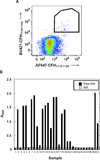A Therapeutic Antibody for Cancer, Derived from Single Human B Cells
- PMID: 27160908
- PMCID: PMC4871760
- DOI: 10.1016/j.celrep.2016.04.038
A Therapeutic Antibody for Cancer, Derived from Single Human B Cells
Abstract
Some patients with cancer never develop metastasis, and their host response might provide cues for innovative treatment strategies. We previously reported an association between autoantibodies against complement factor H (CFH) and early-stage lung cancer. CFH prevents complement-mediated cytotoxicity (CDC) by inhibiting formation of cell-lytic membrane attack complexes on self-surfaces. In an effort to translate these findings into a biologic therapy for cancer, we isolated and expressed DNA sequences encoding high-affinity human CFH antibodies directly from single, sorted B cells obtained from patients with the antibody. The co-crystal structure of a CFH antibody-target complex shows a conformational change in the target relative to the native structure. This recombinant CFH antibody causes complement activation and release of anaphylatoxins, promotes CDC of tumor cell lines, and inhibits tumor growth in vivo. The isolation of anti-tumor antibodies derived from single human B cells represents an alternative paradigm in antibody drug discovery.
Copyright © 2016 The Authors. Published by Elsevier Inc. All rights reserved.
Figures





Similar articles
-
Complement factor H protects tumor cell-derived exosomes from complement-dependent lysis and phagocytosis.PLoS One. 2021 Jun 16;16(6):e0252577. doi: 10.1371/journal.pone.0252577. eCollection 2021. PLoS One. 2021. PMID: 34133431 Free PMC article.
-
Complement Factor H Antibodies from Lung Cancer Patients Induce Complement-Dependent Lysis of Tumor Cells, Suggesting a Novel Immunotherapeutic Strategy.Cancer Immunol Res. 2015 Dec;3(12):1325-32. doi: 10.1158/2326-6066.CIR-15-0122. Epub 2015 Jul 27. Cancer Immunol Res. 2015. PMID: 26216416
-
Molecular Docking and Molecular Dynamics (MD) Simulation of Human Anti-Complement Factor H (CFH) Antibody Ab42 and CFH Polypeptide.Int J Mol Sci. 2019 May 25;20(10):2568. doi: 10.3390/ijms20102568. Int J Mol Sci. 2019. PMID: 31130605 Free PMC article.
-
Complement in antibody-based tumor therapy.Crit Rev Immunol. 2014;34(3):199-214. doi: 10.1615/critrevimmunol.2014009761. Crit Rev Immunol. 2014. PMID: 24941073 Review.
-
Regulation of complement and modulation of its activity in monoclonal antibody therapy of cancer.MAbs. 2014;6(5):1133-44. doi: 10.4161/mabs.29670. Epub 2014 Oct 30. MAbs. 2014. PMID: 25517299 Free PMC article. Review.
Cited by
-
Recombinant human B cell repertoires enable screening for rare, specific, and natively paired antibodies.Commun Biol. 2018 Jan 22;1:5. doi: 10.1038/s42003-017-0006-2. eCollection 2018. Commun Biol. 2018. PMID: 30271892 Free PMC article.
-
Retrospective analysis of the preparation and application of immunotherapy in cancer treatment (Review).Int J Oncol. 2022 Feb;60(2):12. doi: 10.3892/ijo.2022.5302. Epub 2022 Jan 4. Int J Oncol. 2022. PMID: 34981814 Free PMC article.
-
Inside-Out of Complement in Cancer.Front Immunol. 2022 Jul 1;13:931273. doi: 10.3389/fimmu.2022.931273. eCollection 2022. Front Immunol. 2022. PMID: 35860237 Free PMC article. Review.
-
Complement factor H protects tumor cell-derived exosomes from complement-dependent lysis and phagocytosis.PLoS One. 2021 Jun 16;16(6):e0252577. doi: 10.1371/journal.pone.0252577. eCollection 2021. PLoS One. 2021. PMID: 34133431 Free PMC article.
-
Humoral complementomics - exploration of noninvasive complement biomarkers as predictors of renal cancer progression.Oncoimmunology. 2024 Mar 13;13(1):2328433. doi: 10.1080/2162402X.2024.2328433. eCollection 2024. Oncoimmunology. 2024. PMID: 38487624 Free PMC article.
References
-
- Ajona D, Hsu YF, Corrales L, Montuenga LM, Pio R. Down-regulation of human complement factor H sensitizes non-small cell lung cancer cells to complement attack and reduces in vivo tumor growth. J Immunol. 2007;178:5991–5998. - PubMed
-
- Bigner SH, Humphrey PA, Wong AJ, Vogelstein B, Mark J, Friedman HS, Bigner DD. Characterization of the epidermal growth factor receptor in human glioma cell lines and xenografts. Cancer Res. 1990;50:8017–8022. - PubMed
-
- Campa MJ, Gottlin EB, Bushey RT, Patz EF., Jr Complement factor H antibodies from lung cancer patients induce complement dependent lysis of tumor cells, suggesting a novel immunotherapeutic strategy. Cancer Immunology Research. 2015;3:1325–1332. - PubMed
MeSH terms
Substances
Grants and funding
LinkOut - more resources
Full Text Sources
Other Literature Sources
Medical
Molecular Biology Databases
Miscellaneous

